The New York Rangers made magic in 1993-94, carrying their long-suffering fans on a wild Stanley Cup drought-busting ride that still rates among the greatest moments in NHL history. Three seasons later, Wayne Gretzky would join Mark Messier on Broadway as the Blueshirts made an unexpected surge to the Eastern Conference Final, the final season of championship contention for the Rangers for some time.
In between those two runs, however, is the largely forgotten 1995-96 club, one that looked every bit the Cup hopeful the 1993-94 group was until injuries and an ugly trade deadline dashed those hopes.
The core of the 1994 championship team looked refreshed and refocused after a Cup defense that ended disappointingly in the second round of the lockout-shortened 1995 season, despite a first-round victory over the top-seeded Quebec Nordiques. The front office had also added key reinforcements for 1995-96 and the group, guided by coach Colin Campbell, appeared determined to prove that they weren’t a one-season championship wonder.
Messier led the way with 47 goals and 52 assists at age 35, turning in the second-best point total of his 10 seasons with the Rangers. Brian Leetch’s 85 points (15 goals, 70 assists) was the third-highest total of his career. Pat Verbeek, acquired at the deadline the previous season, recorded 41 goals and 41 assists to give the Rangers two 40-goal scorers, a feat the Blueshirts have accomplished only once since.
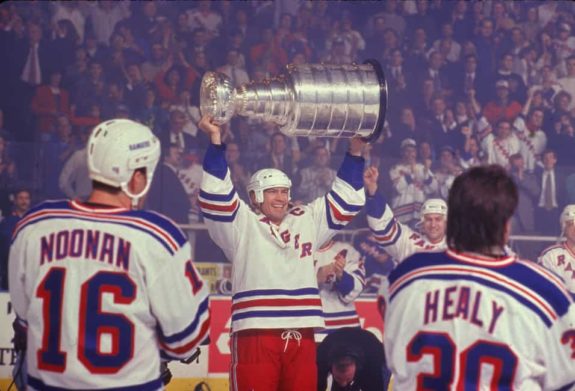
Championship mainstays Adam Graves and Alexei Kovalev contributed solid seasons with 58 points apiece. Luc Robitaille, acquired before the season as part of what would prove to be an ill-fated trade with the Pittsburgh Penguins for defenseman Sergei Zubov, had 23 goals and 46 assists.
And newcomer Ray Ferraro, signed as a free agent away from the archrival New York Islanders before 1995-96 to fill the second-line center hole and whose fate proved to be inexorably linked to that Rangers season, delivered 25 goals in the 65 games he played as a Blueshirt.
1995-96 Rangers Were Physical, Offensively Deep
This was a chippy Rangers team, considerably more so than the 1993-94 champs. The presences of the irritating Verbeek and Ferraro, along with defenseman Ulf Samuelsson – who arrived with Robitaille in the Penguins trade during the offseason – proved infectious, as the Rangers ranked third in the league with 22.4 penalty minutes per game.
Verbeek’s 129 PIMs and Messier’s 122 – easily the captain’s highest total in seven seasons – were indicative of the team’s hard edge. Jeff Beukeboom’s 220 PIMs was the highest total of his career, while enforcer Darren Langdon (175) and Graves (100) rounded out the triple-digit PIM club on the roster, numbers that would be completely foreign in today’s transformed NHL.
With offensive depth, an ability to get opponents off their game and newfound focus after the gleam of 1993-94 had finally been allowed to fade, the Rangers started to hit their stride in November, climbing to 24-10-6 with a month-ending 5-0-1 surge. The high point came Feb. 17, when the club climbed 21 games over .500 at 34-13-11 (ties were still part of the league, with the switch to shootouts 10 years away).
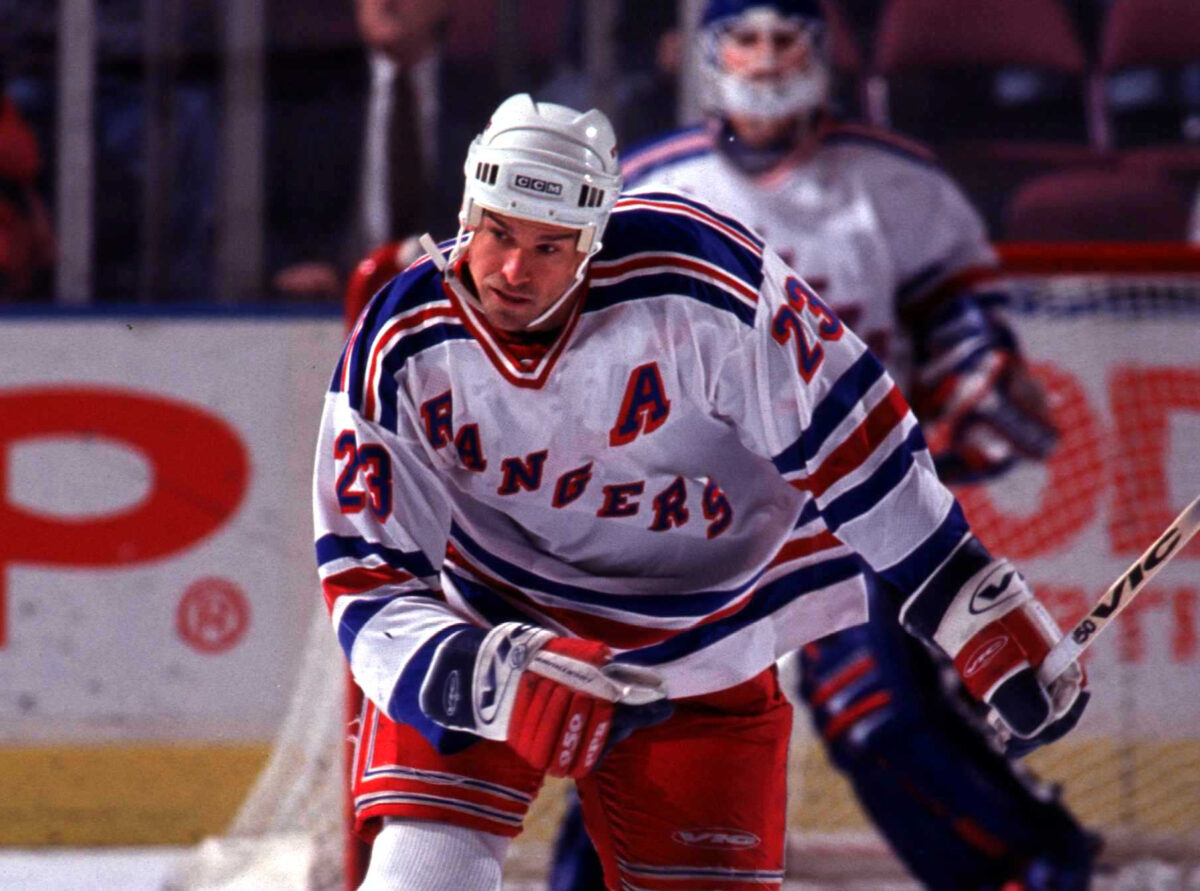
And suddenly, seemingly without warning, the season began to go south.
The Rangers went 3-8-3 in their next 14 games after hitting their high-water mark, their defense looking vulnerable as they allowed four or more goals eight times in that stretch after giving up at least four twice in the previous 13 contests. The Rangers were short-handed a league-high 495 times that season, a figure that perhaps began to catch up to them.
The worst, though, was still to come.
On March 14, 1996, the Rangers attempted to recreate the trade deadline brilliance of 1994, when they remade their roster by bulking up for the playoffs in what at the time was a much more physical NHL. Those Rangers were willing to sacrifice then-current star Mike Gartner and a future one in Tony Amonte, as well as longtime NHL center Todd Marchant in order to add veterans Stephane Matteau, Glenn Anderson, Brian Noonan and Craig MacTavish – all of whom played critical roles in the 1994 championship run.
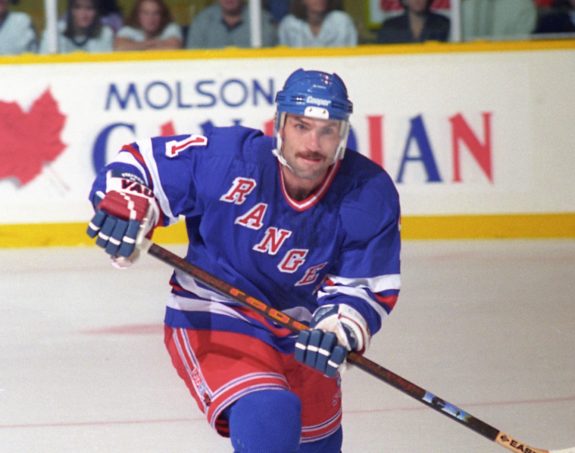
Already a physical team in 1995-96, general manager Neil Smith nevertheless followed his blueprint from two years earlier, deciding to trade skill and future promise for size and veteran grit. Still, his big deal at the deadline seemed even more stunning than the moves of 1994 – Ferraro, defenseman Mattias Norstrom and forwards Ian Laperriere and Nathan LaFayette were shipped to the Los Angeles Kings for Jari Kurri, Marty McSorley and Shane Churla. (from ‘HOCKEY;Rangers Trade for Kurri and McSorley,’ NY Times, 03/15/1996)
Rangers Were Unable to Overcome Trade of Ferraro
Sending away the second-line center who had played such a pivotal role in the Rangers’ outstanding regular season – not to mention a big, promising blueliner in Norstrom and the high-octane Laperriere – was met with plenty of head-scratching, especially because the return was a pair of aging enforcers and a fading Hall of Famer in Kurri. That reaction proved to be well-founded.
The Rangers did manage to right the ship briefly with a 4-1-0 stretch in late March and early April, but five consecutive losses to end the regular season laid bare the effects of the deadline deal. The chemistry and identity that had powered the club for much of the season – in which Ferraro had played a key part – had been altered. The Blueshirts weren’t the same powerful offensive team, getting outscored 21-9 over that closing slide to finish 47-21-14, second in the Atlantic Division, seven points behind the Philadelphia Flyers.
The newcomers mostly underwhelmed. Kurri managed one goal, four assists and a minus-four rating in 14 regular-season games, though he was effective in the playoffs with eight points in 11 contests. The totals for McSorley and Churla shouldn’t have come as a shock to anyone – two combined assists, a minus-nine rating and 47 penalty minutes in 19 games (Churla did score two goals in the postseason).
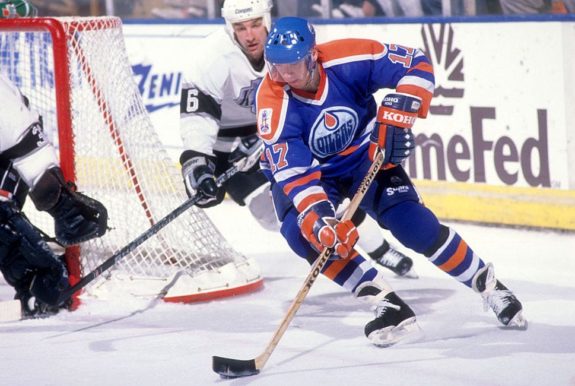
The limp to the end became a literal one of sorts, the struggles hardly due only to the trade. Messier missed the final six games of the regular season with a serious rib injury – a devastating development that, combined with the unsuccessful changes in personnel, proved to be the death blow for a season that had exhibited so much promise. (from ‘HOCKEY;Rangers’ Hopes Hinge on Messier’s Health,’ NY Times, 04/16/1996)
The losing streak extended into the playoffs, with the Rangers dropping the first two games at home to the Montreal Canadiens. They had enough firepower to rally, however, taking four straight and reviving hopes that they were still the Stanley Cup-caliber team they had resembled throughout the season.
The Blueshirts even managed a split of the first two games on the road against the Pittsburgh Penguins in the East semifinals, with Messier recording a goal and assist in each contest. He could barely skate over the final three, however. Mario Lemieux, Jaromir Jagr, old friend Zubov and the Pens outclassed the fading Rangers over the next three games, outscoring them 11-4 in the final two to complete a five-game victory.
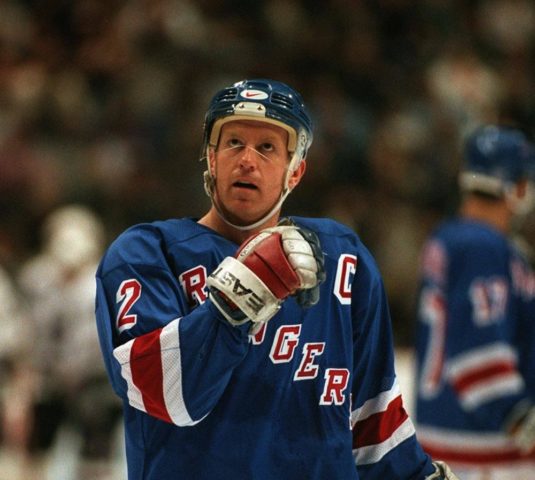
Getting past Pittsburgh, of course, would have guaranteed nothing. Perhaps the Florida Panthers, who would shock the Penguins in the Conference Final as the final step in their stunning run to the Stanley Cup Final, weren’t going to lose to anyone in the East that season. Maybe the powerhouse Colorado Avalanche of Joe Sakic, Peter Forsberg and Patrick Roy, who swept the Panthers to win the Cup, were unbeatable in those playoffs.
Messier Injury, Changed Roster Spelled Defeat for Blueshirts
The Rangers, though, almost certainly wouldn’t have been able to put forth their best challenge to those teams anyway. The devastating injury to their captain and leading scorer that followed the disastrous trade of Ferraro had left the Blueshirts less talented and dangerous than they had been for much of the season, when they had thrust themselves in the championship conversation.
Ferraro would continue to be mostly productive for eight more seasons, while Norstrom went on to develop into a solid defenseman and was captain for six of his nearly 10 full seasons with the Kings, playing 12 overall after the Rangers unceremoniously sent their second-round pick in the 1992 draft away. Laperriere, coveted by the Rangers for his physicality as an ideal fit on an energy line (he was acquired from the St. Louis Blues in late December for Matteau), went on to a lengthy career as just that, playing 16 seasons – nine with the Kings.
Latest Rangers Content:
- Rangers Ink Some Minor, but Important Contracts
- Rangers News & Rumors: Shesterkin, Copp, Strome & More
- NHL Rumors: Canadiens, Flyers, Rangers, Oilers
- Rangers Need to Find a Reliable Third Defense Pair
- Rangers Should Pursue Blockbuster Trade for Patrick Kane
The Rangers’ deadline deal in 1996 seemed a case of trying to force a repeat of a previously successful situation, so much so that Smith would accept a major gap in talent in return (the fact that two of the three players that came from the Kings were Stanley Cup-winning Edmonton Oilers appeared to further belie the notion that blind adherence to a formula that had worked before won out over making a good trade). Smith almost seemed to be reacting out of fear at that time, having also acquired tough guy Sergio Momesso and grinding forward Bill Berg from the Toronto Maple Leafs weeks earlier. It was as if the GM was preparing the Rangers for a street fight, not an NHL playoff tournament.
At their best, though, the 1995-96 Rangers were a handful – high-scoring, deep, experienced, tough to play against. They summoned echoes of the 1993-94 champions for a while, looking primed and equipped to give the Madison Square Garden faithful another run at the Cup deep into the spring. That fate didn’t smile upon the Blueshirts again that year only burnished the memories of 1994 and emphasized how difficult it had been to capture the Cup.
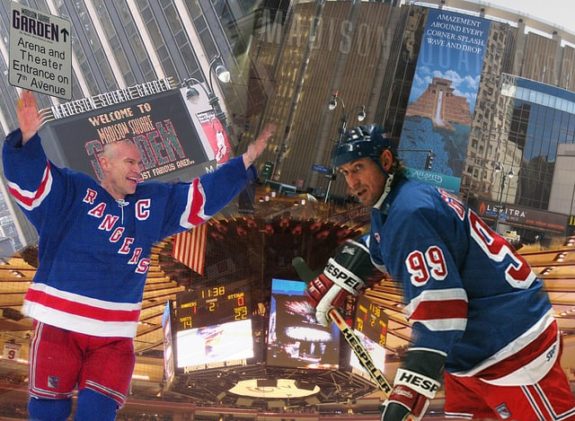
The next season, the Rangers authored their improbable run to the conference finals, with Gretzky and Messier aboard for five-game upsets of Florida in the first round and the top-seeded New Jersey Devils in the second. That reunion of future Hall of Famers and the club’s underdog status, along with the fact that the 1996-97 Blueshirts advanced a round further in the playoffs, has rendered that season more memorable than 1995-96, when the Rangers exited the postseason with a whimper.
Of those two teams, however, it was the 1995-96 edition that might have been the bigger threat to bring a second Cup to MSG in that decade – if only health issues and a misguided attempt to recreate the past hadn’t gotten in the way.